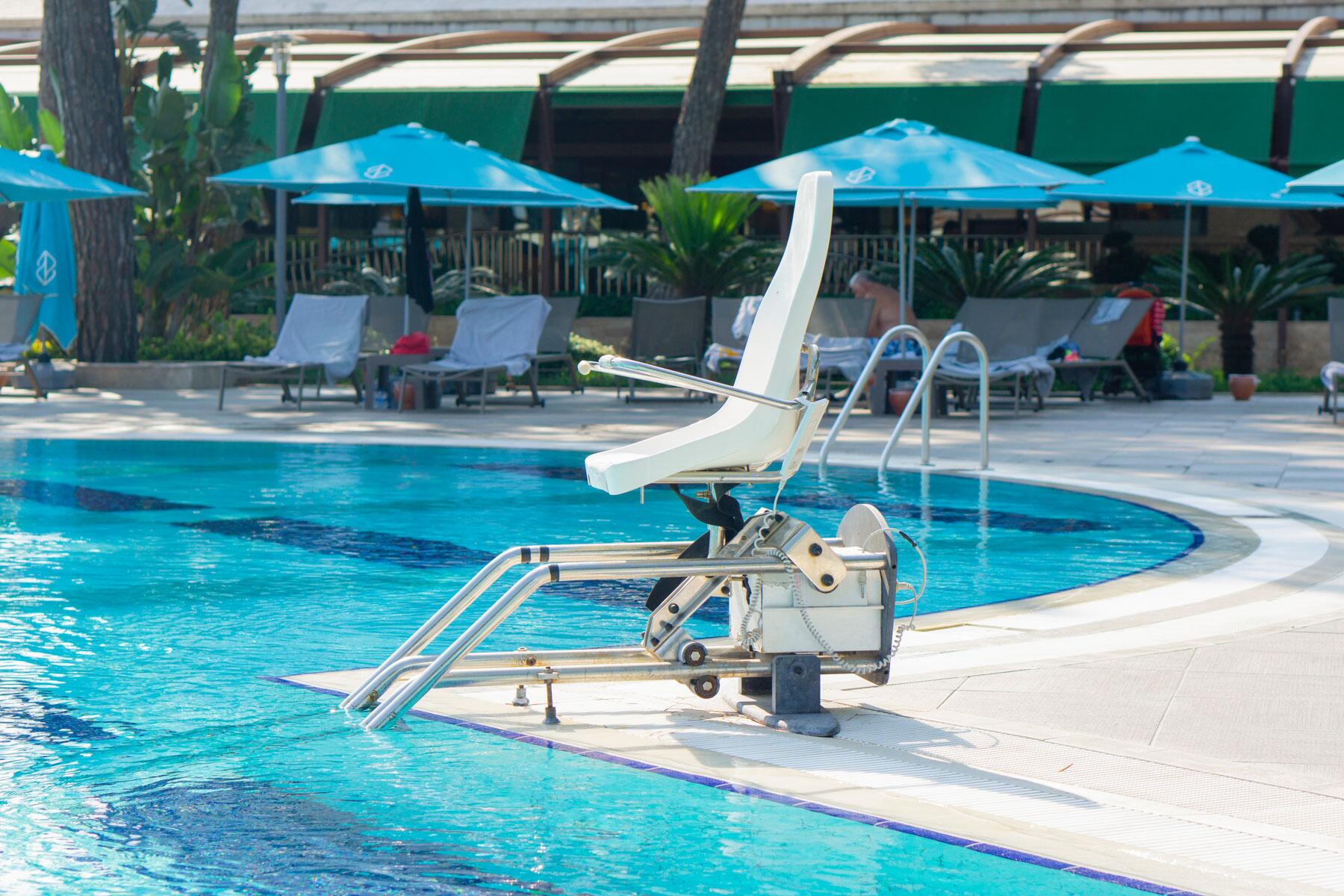Hotels have a long way to go in being truly accessible.
Ihave used a wheelchair since I was 12 years old. And, yes, though there was an adjustment period, though it took time to reconcile myself to life on wheels, I soon came to recognize the distinct advantages my chair offered me.
I was diagnosed with rheumatoid arthritis at the age of 20 months, and by the time I became wheelchair-dependent, the RA had spread to all extremities and every joint, causing deformity, muscle weakness, often severe pain, and extreme loss of mobility.
That meant that propelling myself about with a manual wheelchair wasn’t an option. And, due to significant hip and spine involvement, it also meant that a standard motorized wheelchair wouldn’t do.
To be able to tolerate spending more than an hour or two out of my electric hospital bed, I would need a chair that could accommodate my complex needs. I would require a chair that could tilt, recline, and elevate–the works.
In other words, I would need a chair that offered me the freedom of movement that my body did not.
And a chair like that comes at a premium, not only in price but in size. Think “small barge,” and you’ll be on the right track. What the chair lacks in compactness, though, it more than makes up for in comfort and utility.
Recommended Fodor’s Video
With the chair, I enjoy a measure of independence that would otherwise be unthinkable. I no longer need help repositioning myself in the seat. I no longer have to return to my bed to find relief from the pressure on my lumbar spine. Best of all, I don’t have to ask to be wheeled from place to place. When I am out and about, I am able to autonomously go wherever my whim and four wheels can take me.
Well, almost.
There’s a flip side to such a sweet ride, as anyone who depends on a souped-up motorized wheelchair or otherwise outsized mobility aid can tell you. It’s the simple reality that even ADA-compliant constructions typically aren’t built to accommodate our specialized equipment, nor do they always allow guests with complex needs to lodge in comfort and ease.
The Labyrinth of Lodging Challenges
When you have a complex disability, and you decide to hit the road, you learn pretty quickly that the challenges you might face at home are often nothing when compared with the obstacles you’re likely to face when you venture beyond your usual stomping grounds.
I have learned this lesson time and again when I travel, which is something I love to do. In fact, it was at a recent academic conference held in a luxury hotel in Baltimore, Maryland, that I truly began to appreciate the limits of “accessible” design for persons with complex disabilities such as mine.
Ironically, I had been invited to speak on a disabilities studies panel, but the labyrinth of obstacles that unexpectedly sprang up during our stay revealed more about the accessibility barriers persons with disabilities face than the disability conference ever could.
To be sure, none of this is meant to cast aspersions on the hotel, one of the finest in the city, or its staff, who were kind and conscientious. The hotel’s amenities were grand. The service was assiduous. The property was beautifully maintained and, as far as I could tell, wholly in adherence with ADA standards.
Mountains and Molehills
For all its amenities and for all the rigor that had obviously gone into meeting and exceeding “accessibility” standards, our fine accommodations did not prove very accessible at all.
Because of my particular needs, my family and I were forced to make do, improvise, and ultimately do without the full access I had expected and desired. We were, for instance, compelled to forgo the opening night reception because the ballroom where the event was held could only be accessed by descending a flight of three stairs. Though a wheelchair lift was installed at the landing, it could be operated only with a key, which none of the hotel staff could locate (this is by no means the first time I have encountered such an issue with a keyed wheelchair lift in a public building).
I have heard of such issues time and again in others who use power wheelchairs, scooters, and other motorized mobility aids. Seemingly small obstacles that others might pass over without even noticing can prove insurmountable when you’re non-ambulatory. And they’re all too prevalent, even in ADA-compliant rooms. High thresholds at entryways, balconies, and patios can render entire sections of an “accessible” room off-limits. Sunken lobbies and reception areas can turn a rise of just two or three steps into an immovable barrier.
Battling the “Accessible” Bathroom
Turns out, it wasn’t just accessing the reception area that proved problematic. We also encountered issues with the bathroom in our “accessible” hotel room. Though it would have been more than spacious enough to accommodate a walker or manual wheelchair, with my motorized behemoth, being inside the bathroom was a bit like parallel parking a semi on a postage stamp. ADA requirements for accessible hotel bathrooms require enough clearance for a 60-inch diameter circle or “T” turn. That may be sufficient in many cases, but for those with “special” special needs, that’s often far too little space to use the facilities safely and comfortably.
For instance, in addition to the extended chassis size of my chair, I, like many persons with musculoskeletal disorders, do not have knee joint mobility. My legs are fixed at full extension, and even at 5’3”, my legs alone take up most of the space in an ADA-compliant bathroom.
Attempting to access the toilet, sink, or shower when you have very limited mobility and a large footprint can feel very much like a game of human Tetris. However, the challenges usually don’t end once you’ve done all the geometric calculations you need to actually get to the sink, commode, or bathtub.
For me, one of the most harrowing experiences of my stay came when I tried to use the shower. Per ADA requirements, the hotel had affixed a hard plastic shower bench to the back stall. Unfortunately, the dimensions of the bench were fairly stingy, but because of my hip and spine issues, I am unable to sit at a 45-degree angle. The slightly reclining position at which I must sit required me to, in essence, cling to the edge of the shower bench to keep from slipping off while the back of my head ground against the hard marble tile of the shower wall. The firm plastic of the shower bench made my lower back scream. And so, between the pain in my head and back and the fear of falling, I usually ended each shower in tears.
But I am certainly not the only one to find shower stalls a challenge. Many ostensibly accessible rooms are now provided with bath chairs rather than affixed benches. As anyone who has ever used them knows, bath chairs are notoriously unstable, particularly if you need to use a transfer board. The curved edges of most bath seats make them function pretty much like a reverse seesaw. Those little suckers tend to tip sideways if you so much as breathe on them too hard. If you have balance issues or limited mobility, that can be the perfect recipe for a dangerous fall.
No Rest for the Weary
You definitely have a lot of ducks to line up when you have a complex disability and you’re preparing to travel. For me, though, one of the most important and difficult issues has always been figuring out how I am going to sleep on the road.
At home, I’ve used a fully electric hospital bed for decades. Stationary beds just don’t provide the support my limbs and spine need. Worst of all, I can’t reposition myself in a stationary bed, nor can I move into a sitting or semi-sitting position. This makes it both painful and difficult to breathe. To be sure, bed wedges can help in a pinch, but if you have a severe pain condition, limited mobility, or breathing issues, wedges can’t compare with the ease of an adjustable bed.
And it’s not just the kind of bed you have to worry about. You also need to consider how you’re going to get into and out of it. Platform and high-profile beds may look deliciously stylish, but they can be a nightmare if you are not very mobile. Beds that are very high or low can be uncomfortable and dangerous for those who use a transfer board or who have trouble bending or climbing. Likewise, platform beds can be wholly unusable if you need clearance under the bed for your mobility equipment or a Hoyer lift.
Tips for Putting the “Access” in Accessible
Traveling when you have a complex disability can be daunting, but it is also most certainly doable. Above all, disability cannot, must not, and should not deprive you of one of life’s great pleasures: travel. The key is to know what to look for and plan ahead. So, if, like me, you are one of the thousands of people with “special” special needs, here’s some advice.
Do a Virtual Walk-Through
Before you book your hotel, reach out to the concierge or guest services team and request that they do a virtual walk-through with you. Ask them to video in real-time every area you will want to access during your stay. Get images and, ideally, measurements of thresholds and doorways. Try to have as much of a 360-degree view of the space as you can because often, you will spot instantly potential barriers an able-bodied person might never notice.
Consider Home Comforts
When you’re thinking about what you might need to travel safely and comfortably, look around you. Make note of the essential things you use daily, perhaps even without thinking about them, to make your life easier and more functional. Then spend some time figuring out how you might emulate that at your chosen hotel. For instance, I use a portable shower bench with a transfer pad at home. The seat is generously proportioned and consists of padded vinyl, meaning that it allows me to recline at the slight angle I need without feeling as if my hips and spine are being ground to a fine powder as they would with a harder seating surface.
Be Your Own Best Advocate
As revolutionary as the ADA has been for persons with disabilities, the statutes aren’t without limits. Businesses are only required by law to provide “reasonable” accommodations for guests and patrons with disabilities. That’s a pretty murky line and one that, all too often, does not go far enough to meet the needs of those with complex challenges. But that doesn’t mean, though, that hoteliers will be unwilling to go the extra mile for their guests. After all, that’s what the hospitality industry is all about, right?
So don’t be afraid to ask for what you need. If you need an adjustable bed, collaborate with guest services to see what options might be available. If you need to bring your own shower bench or portable ramp, fight for that right. When you advocate for yourself, you’re not just asserting your own accessibility rights, you’re also smoothing the path for those who will literally and figuratively follow in your footsteps and/or tire tracks!





